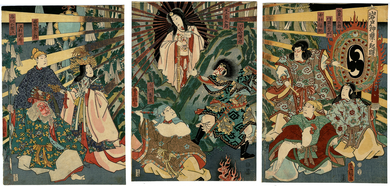Amano-Iwato
 From Wikipedia the free encyclopedia
From Wikipedia the free encyclopedia
This article needs additional citations for verification. (November 2015) |

Ama-no-Iwato (天の岩戸, literally "heaven's rock cave") is a cave in Japanese mythology. According to the Kojiki (Records of Ancient Matters) and the Nihon Shoki, the bad behavior of Susano'o, the Japanese god of storms, drove his sister Amaterasu into the Ama-no-Iwato cave. The land was thus deprived of light.[1]
In order to get Amaterasu out of the cave the other gods called Yao-yorozu-no-kami threw a party outside with wisdom of Omoikane. The goddess Ame-no-Uzume-no-Mikoto performed a lewd dance, eliciting laughter. Amaterasu grew curious about the source of amusement and peeked out of the cave entrance. She became fascinated by her own reflection in the Yata no Kagami mirror which the other gods had crafted and hung before the cave for that purpose, and stood transfixed. Ame-no-tajikarao then forced the cave open and the world was bathed in light once again. As Amaterasu stepped out of the cave a holy seal was applied to it so that she could never go back into hiding.
Higashihongu[edit]
The main shrine called Higashihongu (east hall) and a hall of worship called Nishihongu (west hall) face each other across the Iwato River gorge. The Amano Iwato cave is an object of worship in festivals and is a rock cave on the other side of the Iwato River from Nishihongu. You can see the cave from Nishihongu after participating in a Shinto ritual for purification. Photography of any kind is prohibited.[2]
The grounds contain many plants and old trees. There are also rare ancient ginkgo and Magnolia compressa trees, which have been considered sacred in Japan since ancient times.

See also[edit]
References[edit]
- ^ Philippi, Donald L. 1968/1969. Kojiki. Princeton, N.J.: Princeton University Press and Tokyo: University of Tokyo Press.
- ^ "Amano-iwato Shrine - Japan National Tourism Organization". Japan national tourism organization. Retrieved 3 May 2017.

